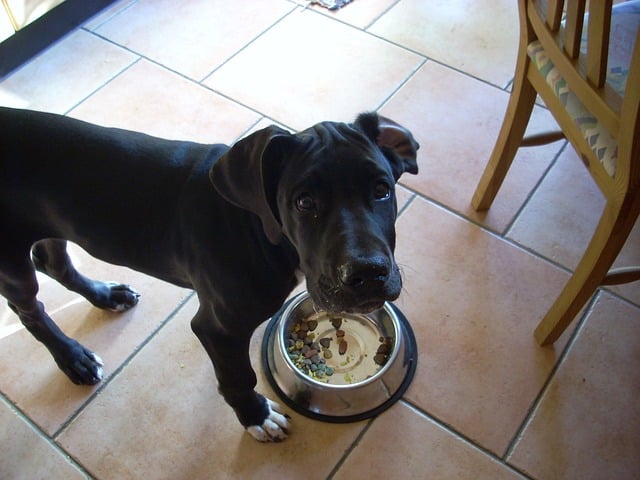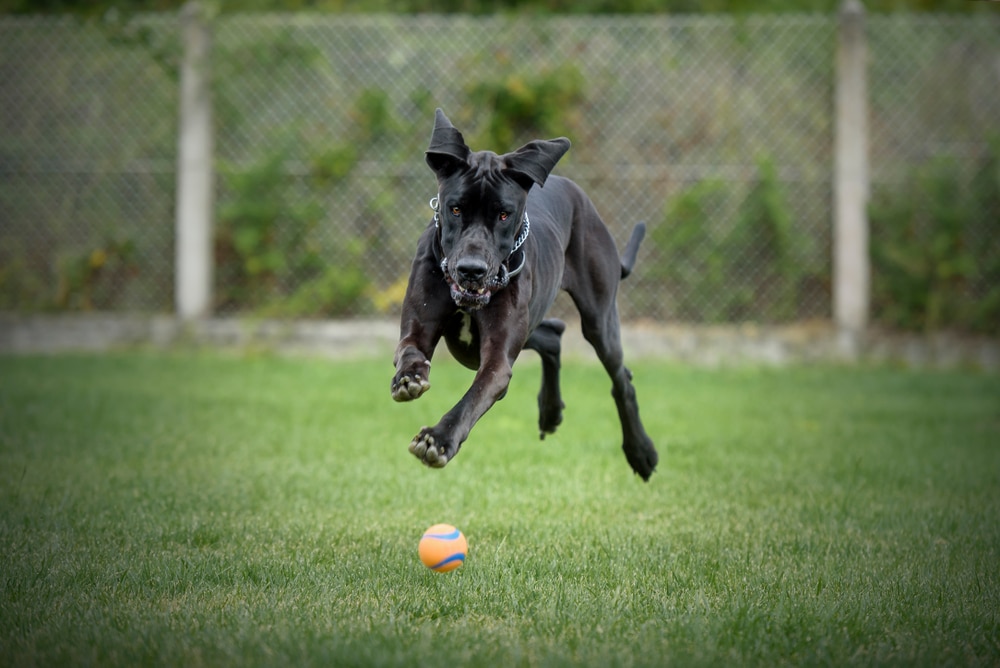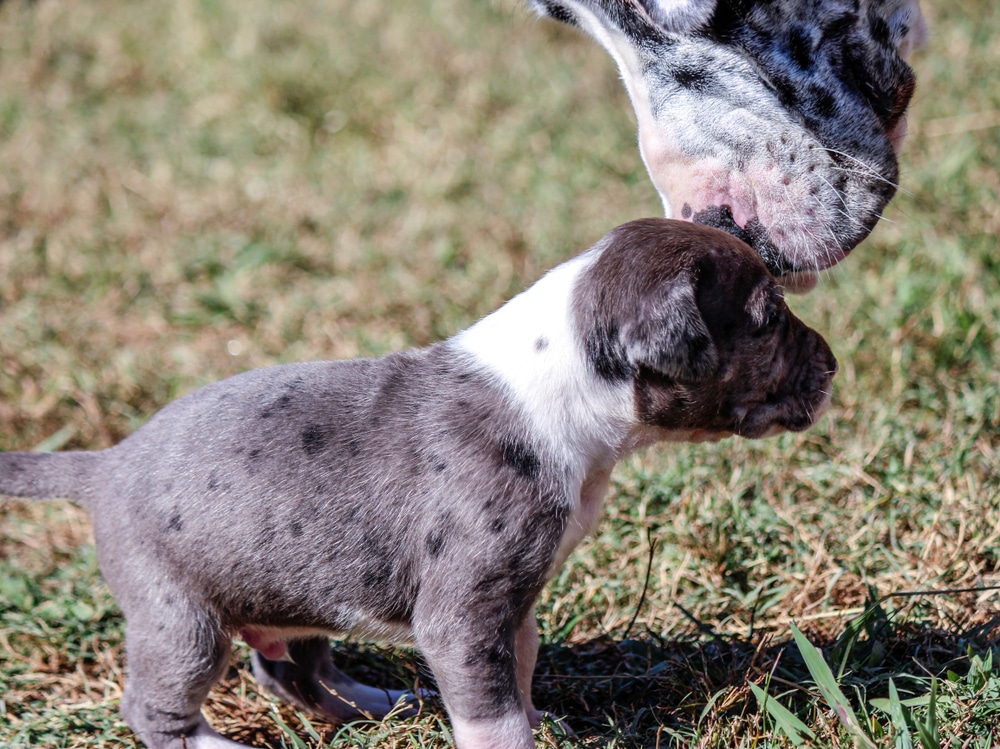“This post contains affiliate links, and I will be compensated if you make a purchase after clicking on my links.”
Last Updated on September 7, 2023
Bloat is among the most common health problems a Great Dane can experience in its lifetime. It is a serious condition and, if not treated, can cause the death of a Great Dane.
In this article, you’ll learn everything about Great Dane bloat – from the initial signs down to the available treatments. Continue reading below!
What Is Bloat?
Bloat is a medical condition where the dog’s stomach fills with gas, food or fluid and later expands. If left untreated, it can develop to a more serious problem called Gastric Dilation and Volvulus or GDV.

GDV is a more serious and life threatening problem. Because when the Great Dane’s stomach becomes bloated with air like a balloon, it can twist in itself. When the stomach starts to twist, it can block the entrance and exit of the stomach. And it can also stop blood circulation to other organs like the heart.
Bloat or GDV is more common in large, deep chested dogs like the Great Dane. Though, it can still happen to any dog breed.
The Dangers of Bloat
According to a UK study, a Great Dane is 8.2 times more likely to die of bloat than any other dog breed. And without treatment, a Great Dane can go into shock in only an hour or two after the first symptoms appear. As the main vein carrying de-oxygenated blood back into the heart is choked due to the Great Dane’ stomach twisting in itself.
Great Dane Bloat Statistics
Below are some statistics that showcases how serious and life-threatening Great Dane bloat is if not treated immediately. The list also shows how high the risk is for Great Danes compared to other dog breeds.
- According to a 2017 publication by the AKC Canine Health Foundation, the Great Dane breed has the highest risk of bloat of any breed with an estimated 37% of Great Dane experiencing bloat or GDV in their lifetimes.
- Another research conducted in 2000 says that an estimated 42% Great Dane develop bloat out of which 13% to 18% die of the condition.
- The same research aforementioned reported that Great Danes were 8.2 times more likely to die from bloat than the average dog.
- A study published in Veterinary Surgery in 1996 reported an estimated 40,000 to 60,000 dogs in the US are affected by the deadly condition each year. And that the mortality rate is as high as 33% (on all dogs) with Great Danes being the breed with the highest risk.
Bloat survival and death rate
The survival rate for Great Dane bloat depends on how long the dog have had it. The earlier you seek veterinary attention, the better chances of survival.
For Great Dane bloat that has been identified and treated earlier, the survival rate is around 80% to 90%. That rate drops to 50% if the stomach is already “dead” by the time of surgery. And the death rate for bloat cases is a shocking 15%-20%. Even when emergency treatment is done, there is still a chance of the Great Dane dying from bloat.
Great Dane bloat can progress very quickly. That is why recognizing the early signs and addressing the issue right away is very important.
Causes of Great Dane Bloat
Even though Great Dane bloat is a common health problem, its primary cause is still unknown and hasn’t been fully understood by experts.

However, according to various studies, there are still a number of contributing factors to the causes leading to Great Dane bloat. And these are the following:
- GDV or bloat tends to occur after a large meal or exercise. (Glickman et al 2000a; Tivers and Brockman 2009)
- Older Great Dane dogs are more prone to suffer from bloat. The risk of bloat occurrence increases with age. (Elwood 1998; Schellenberg et al 1998; Glickman et al 2000a, b)
- Great Dane bloat occurrence is higher in dogs with a close relative (parent or sibling) which has had GDV. (Glickman et al 1997)
- Prevalence is also frequent in thin dogs. (Glickman et al 2000a)
- A Great Dane’s temperament also appears to contribute to bloat. The risk increases in those which have a fearful/ anxious temperament (Glickman et al 1997) or are stressed. (Glickman et al 1997; Fossum 2009)
- When dogs eat rapidly. (Glickman et al 1997, 2000b; Tivers and Brockman 2009)
- When Great Danes eat from raised feeding bowls. (Glickman et al 2000b)
According to a publication by the AKC Canine Health Foundation published in 2017, bloat’s occurrence is also connected to the genetic makeup of a dog.
The study infers that “the lifetime risk of bloat in Great Danes is 62% for dogs that carry one or more of three identified risk alleles as compared to 20% for dogs that do not carry a risk allele”. It is believed that these risk alleles make such Great Dane dogs more vulnerable to bloat “by causing an imbalance in bacterial population of their gut”.
Signs and Symptoms
As a result of gas accumulation in the stomach, Great Dane bloat becomes extremely painful. It can happen at any age and can progress very quickly.
Given the dangerous nature of bloat, you should look out for these typical signs and symptoms of the condition:
- Pacing
- Restlessness and anxiousness
- Trying to vomit or retching
- Swollen and hard stomach
- Drooling
As Great Dane bloat gets worse, you will also notice these signs:
- Labored panting or breathing
- Pale gums
- Rapid heart and pulse rate
- Weakness and/or collapse
- Whimpering or sounds that indicate extreme pain
Nikki Riggsbee, who has bred Great Dane dogs under the McEmn since 1980, states that for Great Dane bloat, “the signs are very consistent. They have dry heaves and bring up white foam and yellow stringy mucous. Their abdomen feels tight and hard”.
Preventing Bloat in Great Danes

While preventing Great Dane bloat is not 100% possible, there are many suggested ways to prevent it. Some of the most agreed upon prevention tips for large breed dogs like Great Danes are:
- Feeding smaller portions. Two to three, or even four, meals are advised for your Great Dane than one large meal a day.
- Avoiding any sort of physical activity right before and after a meal.
- Inclusion of canned and/or wet food to add moisture to your dog’s meal.
- Water must be at your Great Dane’s reach all the time, so that it may not indulge in excessive drinking.
- Having a relaxed, contented and placid disposition can also lessen the danger of bloat for your Great Dane.
- If your Great Dane eats fast, using slow feeder bowls and devices will help. Here are slow feeder options you can find on Amazon:
Over the years, these prevention tips have changed. And there is no doubt that they will still change over the course of time when more studies appear. And with these ever changing results, a solid preventive measure can’t really be made.
Treating Bloat in Great Danes
Great Dane bloat is not the kind of health problem that will go away on its own or can be treated by over the counter medications. So, if you suspect that your Great Dane has bloat, it is best to go to a skilled veterinarian.
Diagnosing Bloat
Veterinarians conduct a clinical examination of the dog to diagnose bloat. The vet will also most likely ask you questions regarding the dog’s history and run various blood tests. Although, the easiest and fasted method to diagnose bloat is through radiography (x-ray).
If the dog really has bloat, the x-ray will show the stomach swollen with gas. And in extreme cases, will also reveal the displacement of the stomach’s opening, further confirming GDV.
Treatment Options
Bloat is a fatal condition that calls for immediate action to ensure the dog’s survival. The longer you wait to treat it, the less chances of survival. That also means, the recommended treatment for bloat varies and depends on how severe the condition has progressed.
First, if it is not that severe, the vet may put a tube on your dog’s throat to reduce the built up pressure on your dog’s stomach. Sometimes, when the stomach has started twisting, the vet will instead put a hollow needle through the belly and into the stomach to release the pressure.
Surgery
If the Great Dane has started going into shock, it means bloat has become so severe that its twisted stomach is causing a lot of damage on the dog’s other organs. When this happens, the vet will stabilize the dog first before doing anything else.
Once the Great Dane is stable, it will be taken for surgery. The procedure will involve putting the stomach back to its original position. If there are damages on the stomach, those pieces will be removed.
And because Great Danes who have been diagnosed with bloat will most likely get this condition again, their stomach lining is “tacked” into the abdominal wall to prevent it from twisting again. This procedure is called Gastropexy.
Prophylactic gastropexy, or simply gastropexy, is the most effective treatment for Great Dane bloat. This surgery is often suggested to Great Danes and other deep-chested canines when they get diagnosed with bloat.
Dr. Clarence Rawlings, surgeon and professor of small animal medicine at University of Georgia, specialized a type of gastropexy called “laparoscopic gastropexy”. It is a minimally invasive surgery compared to traditional gastropexy and only involves two small incisions.
According to Dr. Timothy McCarthy from the Surgical Specialty Clinic for Animals in Beaverton, Oregon, this specialized gastropexy is a very quick procedure and can be done in 15 minutes.
But of course, as with all surgeries, there are always risks that come with the benefits. Complications may arise either from anesthesia, the surgery itself and infections post-surgery. Furthermore, there is no guarantee that the surgery will stop the occurrence of bloat altogether. But it will effectively reduce the chances of the stomach twisting again in itself.
And after the surgery, you can take your Great Dane home according to the vet’s recommendations. Fortunately, if your Great Dane has not suffered from any organ damage, it can be taken back home after several hours of treatment. The veterinarian might also recommend some anti-gas medicine for your Great Dane.
Surgery cost for Great Dane Bloat
Gastropexy may be an easy and swift procedure, but it isn’t inexpensive. A Great Dane bloat surgery costs around $1700 and may vary depending on your location and veterinarian.
Great Dane Bloat and Breeding

As mentioned above, statistics show that bloat has a greater chance of developing in Great Danes that are closely related (parent and/or sibling) with those who’ve had a history of the problem.
However, smart and responsible breeding can influence the occurrence of Great Dane bloat. Some suggested bloat preventive measures from a breeding standpoint are:
- Not to breed from Great Danes that have been directly affected by bloat.
- Not to breed from Great Danes which are closely related to dogs affected by bloat.
- Breeders cross Great Danes with dog breeds that are less likely to develop bloat or GDV.
Conclusion
Great Dane bloat is a fatal and life-threatening health problem that should not be taken lightly.
If you are planning to buy or adopt a Great Dane, make sure that you know their family’s lineage and that no close relative have had bloat.
And if you are currently a Great Dane dog parent, recognition, quick action and access to an experienced veterinarian can help ensure your dog’s survival. If you suspect bloat in your dog, you should immediately seek veterinary attention.

![Great Dane Bloat 101: Signs, Symptoms And Prevention 7 Keegud Slow Feeder Dog Bowls Insert [36 Octopus Suction Cups] Super Firm Eating Bowl [Cuttable] For Large Breed And Medium Size Compatible With Regular Elevated (Turbine)](https://m.media-amazon.com/images/I/415D3+CNKzL._SL160_.jpg)

3 thoughts on “Great Dane Bloat 101: Signs, Symptoms and Prevention”